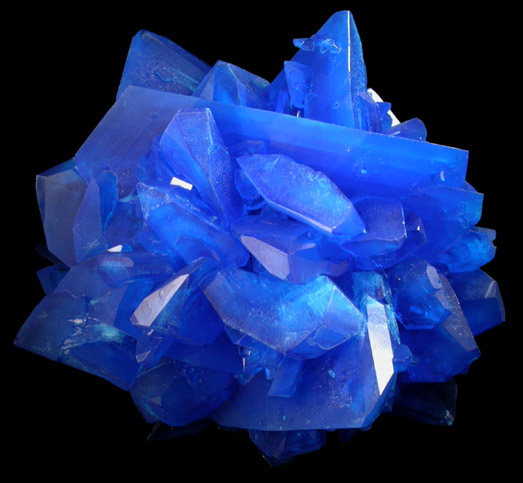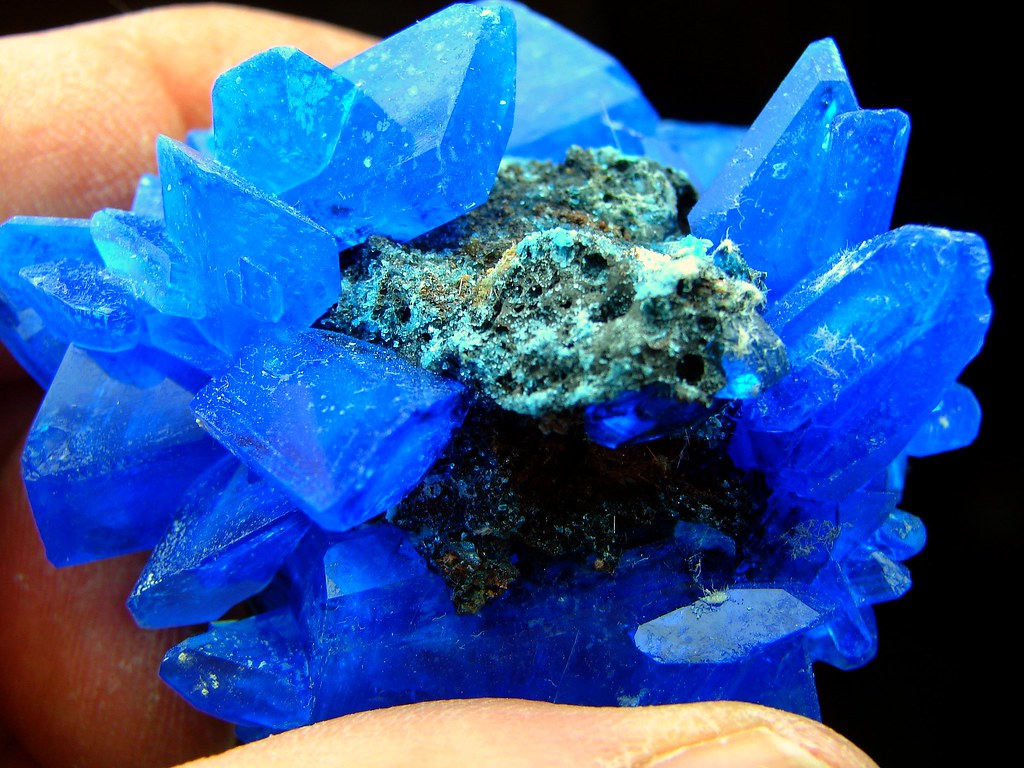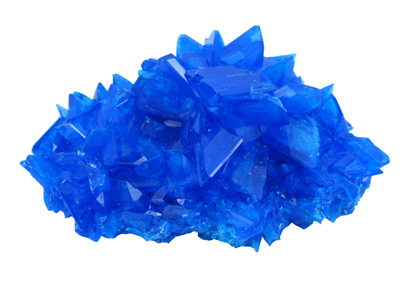Chalcanthite
- Copper sulphate
- Vitriol
Chalkanthit, in chemistry as copper sulphate ( bluestone outdated ), is a rarely occurring mineral from the mineral class of " sulfates ( and Related ) ". It crystallizes in the triclinic crystal system with the chemical composition Cu [ SO4 ] · 5 H2O and usually develops crusty coatings or fibrous or granular aggregates, rarely small, prismatic to tabular crystals in light-to dark blue color. Very rare is to find green to green- blue crystals.
Special Features
Chalkanthit dehydrated in air. It should therefore be stored under airtight as possible, so that the crystals do not fall apart. Too much water dissolves the Chalkanthitkristalle on it. However, it can dehydration in the initial stage by briefly, carefully brushing cure under water.
With a Mohs hardness of 2.5 Chalkanthit belongs to the soft minerals ( with fingernail or be scratched ). Its transparent to translucent crystals show on the surface of resin to glass shine.
Etymology and history
The name Chalkanthit is a combination of two Greek words χαλκός Chalkos for " copper " and ἄνθος anthos for " flower".
First described it in 1853 by Franz von Hess Peter.
Classification
In the now outdated but still in use 8th edition of the mineral classification by Strunz the Chalkanthit belonged to the mineral class of " sulfates, chromates, molybdates and tungstates " and then to the Department of " water -containing sulfates without foreign anions ", where he was named the " Chalkanthit group "with the system no. Formed VI/C.04 and the other members Jôkokuit, Pentahydrit and Siderotil.
The 9th edition used since 2001 and valid by the International Mineralogical Association (IMA ) of the Strunz'schen Mineral classification assigns the Chalkanthit in the extended class of " sulfates (including selenates, tellurates, chromates, molybdates and tungstates ) " and then in the Department the " sulfates ( selenates, etc. ) without additional anions, with H2O" one. However, this is further divided according to the size of the cations involved, so that the mineral is "With only medium-sized cations " to find according to its composition in the subdivision where it together with Jôkokuit, Pentahydrit, Sanderit and Siderotil the " Pentahydritgruppe " with the system no. 7.CB.20 forms.
The classification of minerals according to Dana assigns to the category of " sulfates, chromates and molybdates ", but there in the fine already divided department of " water -containing acids and sulfates ." Here he is with Siderotil, Pentahydrit and Jôkokuit in the eponymous " Chalkanthitgruppe ( Triklin: P1) " with the system no. Find 29.06.07 within the sub-division of " water -containing acids and sulfates with AXO4 • x (H2O) ".
Education and Locations
Chalkanthit formed by oxidation of copper sulphides, mainly chalcopyrite, and it is stable only in arid climates. Very often it can be the Old Man of abandoned tunnels find. Accompanying minerals include Brochantite, epsomite, Fibroferrit, gypsum, Goslarit, melanterite, Morenosit, Pickeringite, Retgersit and Rhomboklas.
Worldwide, Chalkanthit so far (as of 2011) are detected at around 760 localities. Important localities are in addition to its type locality " Chuquicamata Mine" in Chile's Región de Antofagasta, among others, still Bisbee, Arizona, USA, where up to four inches large crystals and up to a meter large stalactites were found.
In Germany Chalkanthit found in several areas of the Black Forest in Baden- Württemberg; in Franconia, Lower Bavaria and the Upper Palatinate in Bavaria; at Dillenburg, in the Odenwald and in Richelsdorf in Hesse; in Lower Saxony Harz; in many regions of the Eifel district of North Rhine -Westphalia and Rhineland -Palatinate; Niederbergisches the country, in the Ruhr area, the Sauerland and winners district of North Rhine -Westphalia; in the district of Mansfeld- South Harz in Saxony -Anhalt; in the Ore Mountains, Upper Lusatia and the Vogtland in Saxony and in Bad Lobenstein, Gera and Saalfeld in Thuringia.
In Austria, the mineral could be found in many regions of Carinthia and Salzburg, as well as on Hochlantsch and Knittel field in Styria and in the Inn Valley in North Tyrol. In Switzerland Chalkanthit previously manifested itself in Obersaxen (Graubünden), Intschi ( Reuss Valley, Uri ) and at Saint- Luc and VS Martigny ( Walli ).
More Locations are Afghanistan, Argentina, Australia, Bolivia, Bulgaria, Chile, China, Democratic Republic of the Congo, Ecuador, El Salvador, France, Greece, Guatemala, Iran, Ireland, Italy, Japan, Kazakhstan, Colombia, Kosovo, Cuba, Luxembourg, Madagascar, Mexico, Morocco, Namibia, New Caledonia, New Zealand, North Korea, Norway, Peru, Philippines, Poland, Portugal, Romania, Russia, Sweden, Slovakia, Slovenia, Spain, South Africa, Romania, Czech Republic, Hungary, Turkey, several regions in the UK, many regions of the United States and Cyprus.
Crystal structure
Chalkanthit crystallizes in the triclinic space group P1 ( Raumgruppen-Nr. 2) with the lattice parameters a = 6.12 Å; b = 10.72 Å; c = 5.96 Å; α = 82.4 °; β = 107.3 ° and γ = 102.6 ° and two formula units per unit cell.
Use as raw material
Chalkanthit is an important copper ore.










